The Wall Street Journal recently posted a scathing indictment of K-12 education in Illinois, drawing on research by conservative Illinois thinktank Wirepoints. The article and research show a perverse form of “equity” in Illinois schools: across the racial spectrum, nobody can read.
Below is part II of Wirepoint’s report, slightly abbreviated. For part I, click here.
It’s all a facade
In a system with this much failure it’s easy to fault everyone involved with the
city’s education system, including Decatur’s parents. But before we assign parents their share of the blame, let’s first look at what the education system is selling to the public.
Take a spin through the Illinois Report Card data for Decatur and you’ll find lots of statistics that say children are performing well, along with evaluations that grossly inflate the competence of Decatur’s teachers and schools.
You’ll also find that Decatur students are pushed through elementary and middle school even though no more than 16 percent in any given grade can read or do math at grade level.

We’re also harsh because nobody in the system wants to upset the apple cart. The rewards are just too lucrative. The Illinois Constitution and multi-year labor contracts guarantee job security, big salaries and even bigger pensions for those in education. The sprawling district bureaucracy provides thousands of administrative jobs. Not to mention the back-scratching relationship between unions and lawmakers that protects the status quo.
This report focuses on Decatur School District 61 because it’s arguably the poster child for the education system’s failures. Just 9 percent of Decatur’s 3rd-grade students can read at grade level. And every year the district graduates hundreds of students who are grossly unprepared for either college or a career.
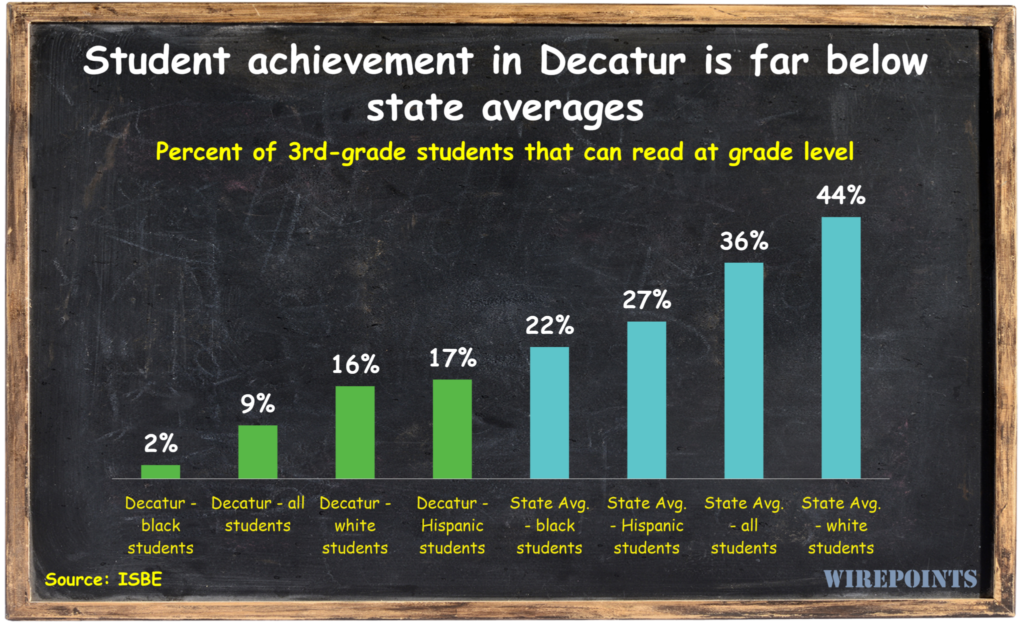
“Social promotion” – pushing kids into the next grade regardless of ability – leaves unsuspecting Illinois parents believing their kids are being educated simply because they’re advancing. But it actually leads to higher dropout rates and lower rates of graduation, according to the Annie E. Casey Foundation, crippling students’ future chances for success.
In contrast, states like Florida outlaw social promotion. They require students to stay in 3rd grade until they absolutely have the skills they need to move on to the next grade. (Credit to State Rep. Rita Mayfield for trying to pass a similar bill in Illinois.)
Social promotion in Illinois continues into high school. That’s when district officials tell parents what they want to hear – that their children have what they need to graduate.
In 2019, 70 percent of all Decatur 9th-graders were shown on the state report card to be “on track” to graduate. Never mind that only 9 percent could do math at grade level the year before.
Who is it that’s allowing such bad outcomes to persist without intervention? Administrators? School boards? The Illinois State Board of Education? State lawmakers? And where are the parents in all this? Does anybody care?

Most Decatur parents also see their children get a diploma, something they’re sure to be proud of. In 2019, 74 percent of Decatur seniors graduated. But that graduation rate is a facade. The district’s 2019 SAT scores show that only 11 percent of 11th-graders were proficient in math and only 13 percent were proficient in reading. Students are being pushed out of the system with no regard for their college or career readiness.
The Illinois State Board of Education is also complicit by selling feel-good numbers on teacher and school quality.
Decatur parents are being told their teachers are great based on what the state report card says. Over 97 percent of Decatur educators were evaluated as “excellent or proficient” in 2017. In 2018, 99.7 percent were rated “excellent or proficient.” So, Decatur has virtually no teachers that need improvement?
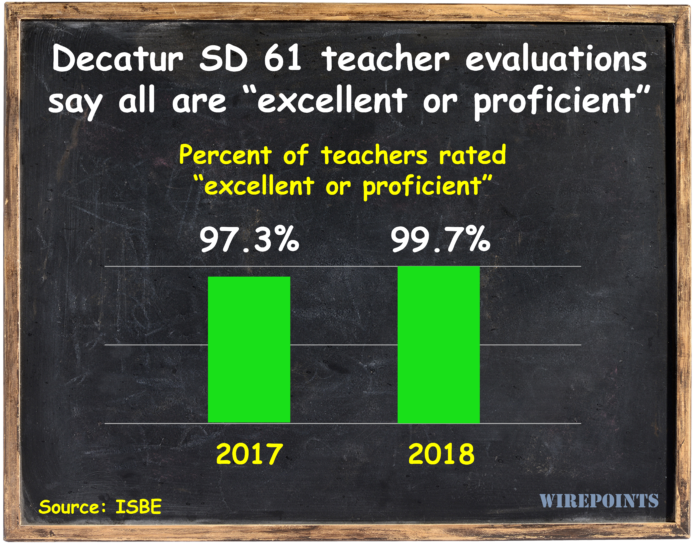
And that’s not just true of Decatur. ISBE’s report card says that 97 percent of teachers statewide were rated “excellent or proficient” in 2019. Illinois’ teacher evaluation process is broken.
Then there are the state’s four “Summative Designations” for schools. Despite their dismal student outcomes, a third of Decatur schools were given the state’s 2nd-highest rating of “commendable” in 2019.
Take Decatur’s Montessori Academy for Peace, for example. There, only 6 percent of black students can do math and only 15 percent can read at grade level. And in Robertson Charter School, only 2 percent of all students can do math and only 7 percent can read at grade level. Yet ISBE labels both those schools as “commendable.”
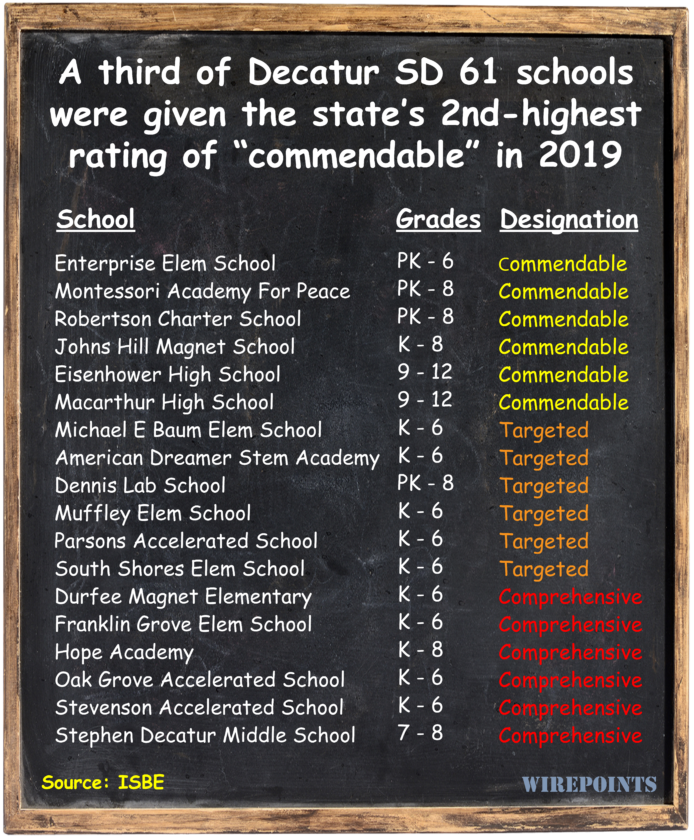
It’s the same story everywhere
Decatur may be the poster child for the education system’s failures, but it’s far from the only example. The same story of poor student achievement and near-zero accountability can be seen across the state.
Take, for example, reading proficiency for black 3rd-graders in 2019. In Rockford, just 7 percent were proficient. In Dolton SD 149, 7 percent. In Cahokia, 5 percent. In Peoria, 8 percent.
Same for Hispanic 3rd-graders. In Elgin, just 11 percent could read at grade level. In Waukegan, 16 percent. In Aurora East, 13 percent. Harvard SD 50, 9 percent. And it’s not just minorities who are failing. Just 15 percent of white 3rd-graders in East Alton could read at grade level. In Quincy, 28 percent. In Mount Vernon, 25 percent. And in Plano, 11 percent.
Chicago Public Schools outcomes, while higher, still leave only a quarter of the district’s 330,000 kids able to read or do math at grade level.
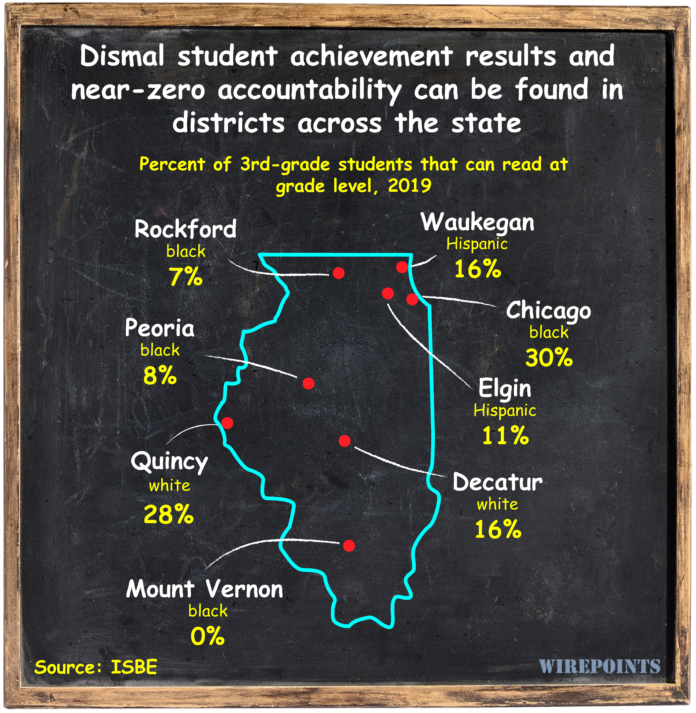
Yet the parents in districts like these are told their children are performing well. A majority of students are listed as “on track” to graduate, ranging from 56 percent “on track” in Waukegan to more than 87 percent in Mount Vernon HSD 201. Parents are also told their student’s teachers are top-notch. The share of “excellent or proficient” teachers ranges from 91 percent in Chicago to 100 percent in Decatur and Mount Vernon.
And while a majority of students in these districts do end up graduating, ranging from a low of 66 percent of students in Rockford to 84 percent in Quincy, most are not graduating college or career ready. Less than a quarter of 11th-grade students can read or do math at grade level in most of those districts.
That represents tens of thousands of students pushed up and out of Illinois’ education system every year without the basic skills they need.
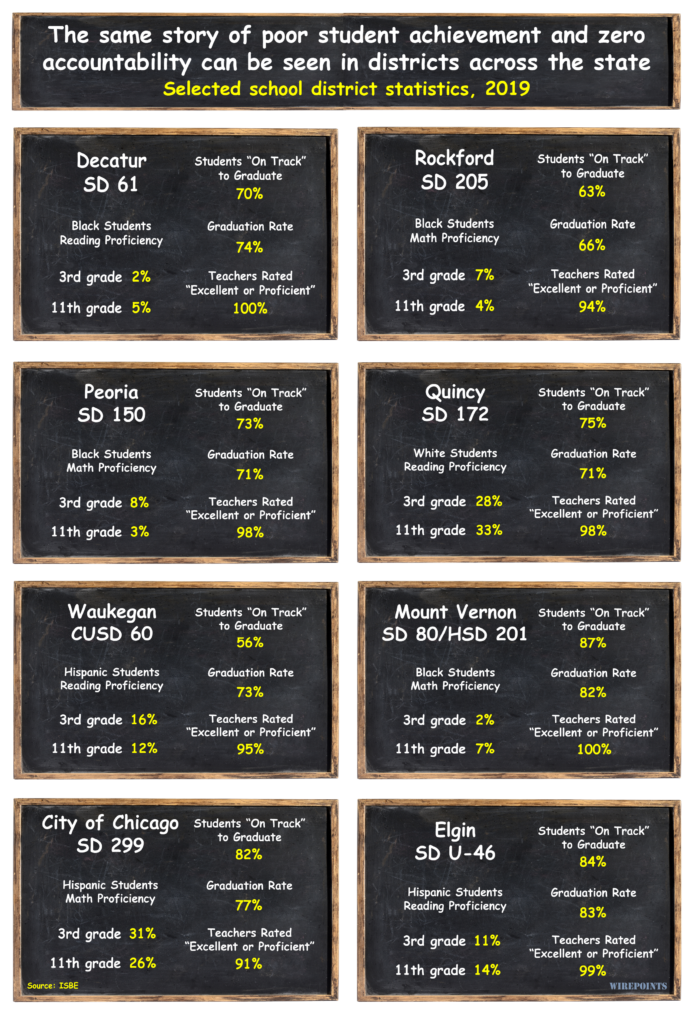
Coming tomorrow in Part III –
Illinois’ educational-industrial complex
How does Illinois’ education system remain intact given its many failures? The answer is simple: it’s designed to self-perpetuate.








